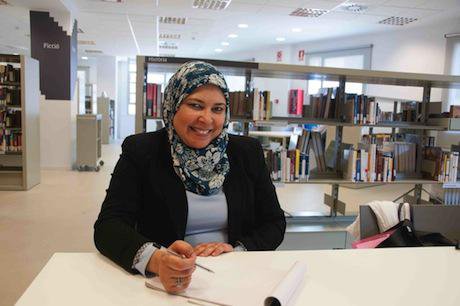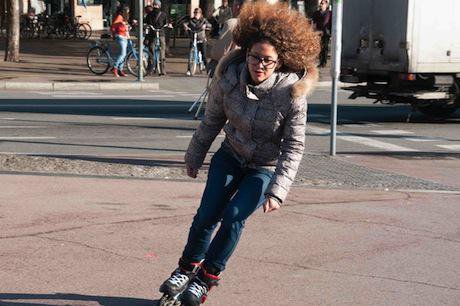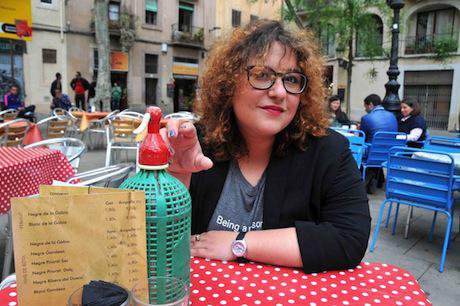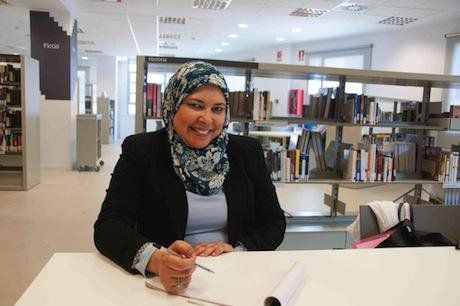The very detailed and almost intimate contributions by these 16 women offer a panoramic view of the ways in which, as Hannah Arendt has said, the social arises.


Fatima. UNU-GCM. All rights reserved.In recent years, and in line with efforts to ‘mainstream gender’ into discourses on migration, it has become common parlance, mostly in discussions of economic remittances, to refer to the feminization of migration.
Upon reflection, this terminology seems somewhat absurd. Not only is migration as old as humanity itself, but logic tells us that humanity would not have survived to live out its endless migratory story if it had not been for women, as well as men, on the move. Indeed, in 2013, according to the United Nations Population Division, of the 232 million people living and working outside their own countries in order to support themselves and their families, approximately half were women.
The ‘feminization of migration’ is a term that aims to acknowledge the role played by women in transnational and trans-local economic circuits, as contributors to economic growth via existing structures and systems of global finance. It is thus apparently feminist in its effort to recognize the roles played by women as motors of economic growth. It is also, in fact, an occlusive term, one that perpetuates existing hegemonic structures of patriarchy – for is it not somewhat patronizing to not also masculinize migration? – and that perpetuates also the priority of capital over the social.
What this does is to ignore two important facts: firstly, that migration has always been a gendered experience affecting both men and women and secondly, that to not include gender considerations in migration is to disregard a fundamental social pathway through which people navigate the world both subjectively and collectively.
Against this backdrop, the Women of the World: Home and Work in Barcelona project was conceived. With this project we want to move away from other much highlighted perspectives on female migrants, those of women as victims of migration, subjected to exploitation, trafficking, illicit activities or slavery. Instead, the focus here is on women who are diasporic citizens of Barcelona and who, as social actors, form part of the urban mainstream in and through the detail of their everyday lives. They too make up the collectives of immigrants that western economies draw on for their labour force and that politicians decry in their nationalist agendas. They form part of the communities that bring forth and raise members of the next generation, and they are also the bearers of diversity and hybridity into societies that often have yet to come to terms with such concepts.
They engage in transnational links, financially and socially, function as nexus points of the local and the global, and hence propel the complicating and layering of experiences of time and place. Their trajectories all too often impact on the places and societies they came from, as well as on the city that hosts them. In this sense, the mobility of the migrant both connects and disconnects, unsettling the cohesion of place and identity.
Home, work and the city
My aim in this project has been to approach the lives of these women through the three tropes of home, work and the city. Rather than consider these as discreet categories, I would like to analyse the connections between tropes, with particular focus on the role played by immigrant women in negotiating these connections. What impact do these individual trajectories have on socio-cultural change and agency for women who are doubly otherized, firstly on account of gender and secondly on account of being immigrants.
Together with Tatiana Diniz, who collected in-depth recordings and documentary portraits of 16 first generation immigrant women in the city of Barcelona, we have mapped the way in which gender intersects and interacts with the migrant experiences of uprooting, trajectories, relocations and negotiations of culture and identity across differences of location and culture.
Their decision to share their stories was voluntary. The methodology of research used, in a bid to open spaces for the subjects to be seen and heard, has drawn on oral histories and documentary photography. The result is an archive of images and audio recordings through which the subjects narrate and represent their individual trajectories to Barcelona, as well as their relationship with this city that hosts them and that they have made their own. The subjects of our enquiry are willing collaborators, who were invited to determine how and where they were seen and heard. The subjects also harnessed their oral narratives to the ethnographic context in which the conversations took place, collaborated in the photographic efforts and are aware that these will be edited and re-presented in the course of creating multiple pathways and outlets for the project to the public realm.
The larger context of mobility

Joice. UNU-GCM. All rights reserved.We started by asking how individual experience may connect with the collective, how home may link with work, and how the private may overlap with the public. Immediately, a range of other issues surfaced, namely those of leaving home, travel, relocation, remaking home, labour or employment, changing perceptions of self and other, building or maintaining local and transnational networks and communities, mapping one’s way in new contexts and remaking the city. It also became clear that perceptions of the self in gendered terms coloured the ways in which the women perceived themselves and shaped their identities, but the experiences of relocation also extended and altered such perceptions in many important ways.
Several questions arise as a result. In what ways does the process of remaking home in a new context connect with that other vital process for immigrants of finding work? To what extent is the question of home defined by that of work and to what extent, for immigrant women, does home provide a space apart from work where gender practices, cultural memory, customs, values and rituals together create a sense of belonging? For many immigrants, work in the host country is also synonymous with the world outside. It is also the vital node through which citizenship, belonging and a sense of affiliation with place is constructed. In turn, places too are constructed, defined and redefined through such affiliations.
The border zone of home and work forms the fine and shifting line where mobile subjects cross over from being migrants to becoming immigrants. This is so because work opens up routes to social interactions, public engagement and networks. The dichotomy of home and work relates directly to questions of inside and outside and hence to that of the private and the public. Framing this dichotomy is the larger context of migration to urban contexts.
To locate migration as one of the motors that drives globalization is also to engage with the paradoxes of immigrant experience: apparently neat divisions of spaces, fields and places, such as those of home and work, assume unexpected overlaps and contradictions. In turn, the very presence of immigrants and diasporas render cities into nodal points on global pathways, where the local is in complex imbrication with the global.
Home, the unheimlich and everything in between
The voices and faces of the 16 women interviewed in the Women of the World project must be encountered within and against this larger context of mobility. With the idea of home as a central axis to this project, I would propose that its findings be considered in light of a theoretical framework in which Homi Bhabha’s reworking of the notion of the unhomely has evolved from Freud’s study on the unheimlich, and seen in the light of Hannah Arendt’s analysis of the public and the private.
My argument here is that questions of home, work and the city for immigrant women must be regarded in a larger, global and local context of the unhomely, whereby the everyday, the public and the domestic as evidenced by the subjects through their narratives, come together under the guise, not of an organized politics or struggle, but of a politics of gender that both mobilizes the urban weave and is mobilized by the latter.
In her book The Human Condition (1958), Hannah Arendt critiques the rise of modernity in terms of an eclipse of the political by the social, which also makes incursions into the private, hence eroding the distinctions between the public and the private. Arendt’s arguments stem from her definition of the social as the overwhelming of the public realm by material and economic forces that render it a function of what were previously private needs. This, in turn, has led to the erosion of the boundaries between the public and the private. The overarching frame of reference for Arendt is that of modernity, understood as characterised by the centrality of capital, technology and profit over nature or the human, where the social dissolves distinctions in what is, in effect, the monopoly of capital as power.
Within this context of alienation, Arendt seeks out the conditions under which freedom, plurality and action, as the axes of the political, can exist. Indeed, freedom and plurality together form not infinite choice, but the ability to exert agency, to do the unexpected, to overturn the existing hegemony or status quo. Plurality, for Arendt, is to be found in the small actions that break new ground, introducing the unexpected into the world. It is also an acknowledgement of the differences and uniqueness of human life and endeavour: at once equality and distinction. "Because," she states, "we are all the same, human, in such a way that nobody is ever the same as anybody else who ever lived, lives, or will live."
In the face of the erosion of the private and the public and against the grain of an overridingly materialistic society, plurality and freedom become routes to a participatory democracy that overturns elitisms. Throughout Hannah Arendt’s work, she makes reference to the idea of the polis. Action and narration are key ways in which the polis is brought to life. By this term, she refers not to a state or authority, but to the impact on the public realm by the action of citizens, despite the latter not being organized. There is, indeed, a theatricality to the idea of polis, a sense of excitement at that which comes into being and heralds change. The polis is the scene of change, where the blurring of the public and the private make it possible for individuals to engage, albeit in contingent, differentiated and unique ways, in processes of collective action in the name of change. Arendt states that "the polis, properly-speaking, is not the city-state in its physical location; it is the organization of the people as it arises out of acting and speaking together, and its true space lies between people living together for this purpose, no matter where they happen to be."
Barcelona as the stage

Serenella. UNU-GCM. All rights reserved.In taking Barcelona as the stage where immigrant women, without doubt a minority within a minority (currently approximately 145,000 immigrant women are registered in this city of around 1.6 million), recount their stories and collaborate to be photographed, our aim has been to explore the germ of this polis, a politics of gender shaped by the everyday actions, migratory experiences, narratives, memories and hopes of very diverse women, each of whom contributes to shape and direct a gender politics that arises from such a polis.
Home, understood as place, origin, belonging, privacy, intimacy and security, is unleashed into the world, and vice-versa. The subjects of home, the disempowered, are thus also released into the public space, at once displaced and also, paradoxically, liberated to formulate in the making of the everyday, a politics of resistance and survival. In reworking the Freudian notion of unheimlich, Bhabha draws on the idea of liminality, a conditioning aspect of the migrant and the deterritorialized that disturbs the stability of what is known or expected. The liminal signals an in-between space, one where discreet categories become confused, where the private and the public, the home and the world lose their specificities in favour of shifting and contingent spaces of uncertainty – precisely, the premises upon which the deterritorialized engage in a politics of empowerment. This is apparent, not so much in terms of a formalized politics of struggle or in terms of large-scale revolutionary actions, but rather in terms of the everyday strategies and mobilities engaged in as acts of survival.
Transitions, mediations and the insignificant
In this context, I would like to highlight three out of many themes that arose from the interviews collected. The first is that of transitions, the second that of mediations and the third that of the significance of the insignificant.
All three work in different ways to allow this city of Barcelona to become the space in which, and from which, new social equations, relations and perspectives are forged. All three are inter-related aspects of the processes at work when engaging with the profound and abiding un-homeliness of migrancy. Indeed, the condition upon which these processes take place is the very strangeness of Barcelona to the subjects when newly arrived. It is in the frame of this overriding strangeness, the unhomely, that these themes should be tracked. In following this thread, what becomes apparent is also the fact that the ground of the unhomely leaves open the conditions for social and urban transformation.
Migration and relocation are, by definition, processes of transition. Yet, as several of our interviews reveal, there is a process at the heart of immigration, which continues long after the formal access to rights and representation that accompany citizenship. Shifting over time and across place, it is the gradual and variegated process whereby the subject engages in developing a sense of new belonging through the ebb and flow of plural identifications to place. "Yes, at heart I will always be Venezuelan and belong to Caracas, which is my city," says Joice, "but over time you get more into the city where you live and have a context, friendships, places you frequent, habits… Yes, I feel like I belong now." Serenella, on the other hand, reflects on the ways in which she has come into her own through migration. "When you leave your country," she states, "you are alone. Even if you have contacts, people, you are alone. At first, it’s scary. Then it’s cool. Yes." Fatima talks in more visceral terms. The smell of Spain, according to her, was what she first noted, a smell of milk that was different from that of her native Morocco. Over time, she too has come to smell of Spanish milk, something that she notes when going back to her country. Fatima talks of a low psychological state when she first came over, one that was characterized by low self-esteem. However, she states, "it is what Darwin called evolution. If you do not evolve, you cannot survive. Without realizing it, you leave some things behind and acquire others." Interestingly, Fatima and some others expressed a dislike of the term ‘integration.’ Instead, in remaking home in Barcelona, they are engaging in a life-long process of transition, one that responded to, and was contingent upon, the abiding un-homeliness of the migrant.
Unfinished transitions produce mediations. For some of the subjects involved, this is an intensely private process. Others use this as a means of empowerment and navigation. Deepti, for example, offers courses on Indian culture to Catalans interested in visiting India that allow her to externalize and formalize the mediatory process, whilst also positioning her strategically as a link between the two cultures that define her world. "I try to bring positive things," she says, "and I try to approximate the millenary culture of India… I bring India to them here." Her work as a cultural entrepreneur takes her in different directions that lead to this goal, as a teacher, guide, translator and entrepreneur. "I feel I am from both places," she states, "I am from here and from India." Bombo, from Senegal, speaks of having embarked on a mediatory role prior to migrating to Barcelona. Her work there as a trainer on a project relating to empowering women to work found a new political accent in Spain, where laws prevented women who had rejoined their husbands from working. "Bit by bit, through the struggle with the women, we have managed to really see this law change… When you are very determined to make things happen, you do not lose hope," she states. Mediation, for Bombo, is collective, as well as subjective, an act that aims to relieve immigrants of the poverty and precarious living that can accompany transcontinental migration through the legal empowerment of immigrant women. For Ling Ling, from China, the transmission of her home culture in Catalan associations, such as the one in Fort Pienc, enable her to feel integrated. As such, her mediatory role as a Chinese resident in Fort Pienc is precisely a route to constructing and maintaining a sense of belonging through organized acts and activities that connect Catalans with Chinese. For these women, a key way for constructing home is precisely through the paradoxical act of mediation, that at once pronounces distance from the home culture and connection with it.
The experiences and efforts of the subjects of the Women of the World project offer a glimpse into the ways in which the latter make contributions to civic life in Barcelona. Yet, when asked what they contribute to this city, some said that they were just a ‘grain of sand’. At the same time, others spoke in more emotionally charged terms, stating that they brought to Barcelona their energy, their love, and their good will. Yet others spoke of the skills, diversity and knowledge they divested in this city, stating at the same time that each was just one person in the city.
Indeed, none of the subjects radically alters Barcelona. Yet, it is precisely through the everyday details of their migrant experiences and their presence, the processes of transition and mediation that they engage in daily, that the significance of the insignificance comes to light. This is the plurality of action on the part of the individual subject of modernity that Arendt emphasizes, the condition upon which social renewal can take place.
Each of the subjects interviewed might be invisible or only partly visible in her own light, but a collective gendered force arises through them that slowly, but surely, alters the contours of Barcelona’s cultural landscape.
To return to Homi Bhabha, his reworking of the unhomely rests on Arendt’s argument that distinctions between the private and the public in the modern age have dissolved. The home acts as an ante-theatre for public realms, as much as the public makes inroads into the domestic and the private. Home, work and the city are experienced as borders, contingent and often precarious, but always the theatre for a strategy of empowerment at once subjective and collective. The very detailed and almost intimate contributions by these 16 women offer a panoramic view of the ways in which, as Hannah Arendt has said, the social arises from the "the shadowy interior of the household into the light of the public sphere." It is the breakdown of the boundary of the private that unleashes modern lives and mobile subjects into the larger, social and political realms and uncertainties of the public sphere.
The home is in the world and vice-versa. What this leads to is a revision of the city as public space, or polis, articulated through a liberating mode of gendered, and hence human, relations.
References:
Hannah Arendt, 1958, The Human Condition, Chicago: University of Chicago Press
Homi Bhabha, 1994, The Location of Culture, London: Routledge
Bernard Charles Flynn, ‘Foucault and the Body Politic,’ in Man and World, Volume 20, Issue 1, p.65-84

